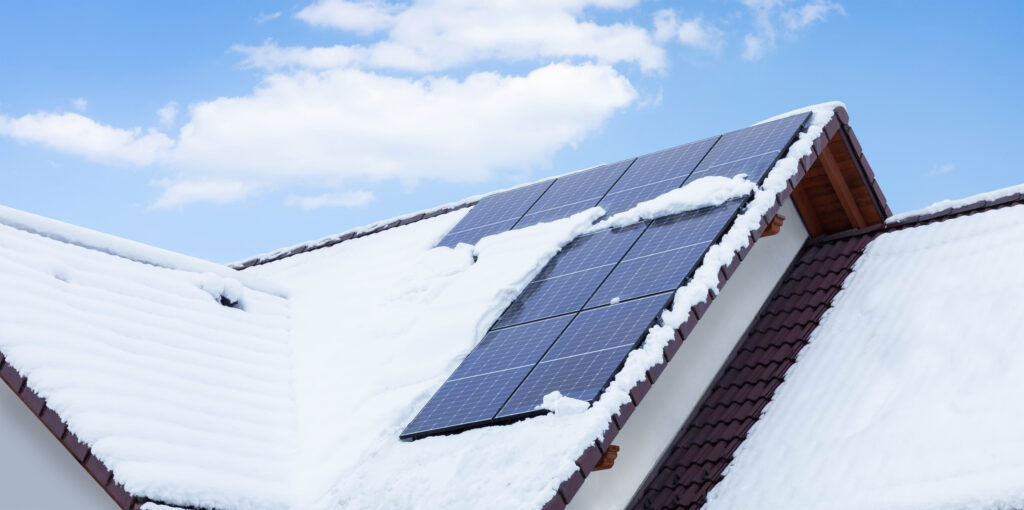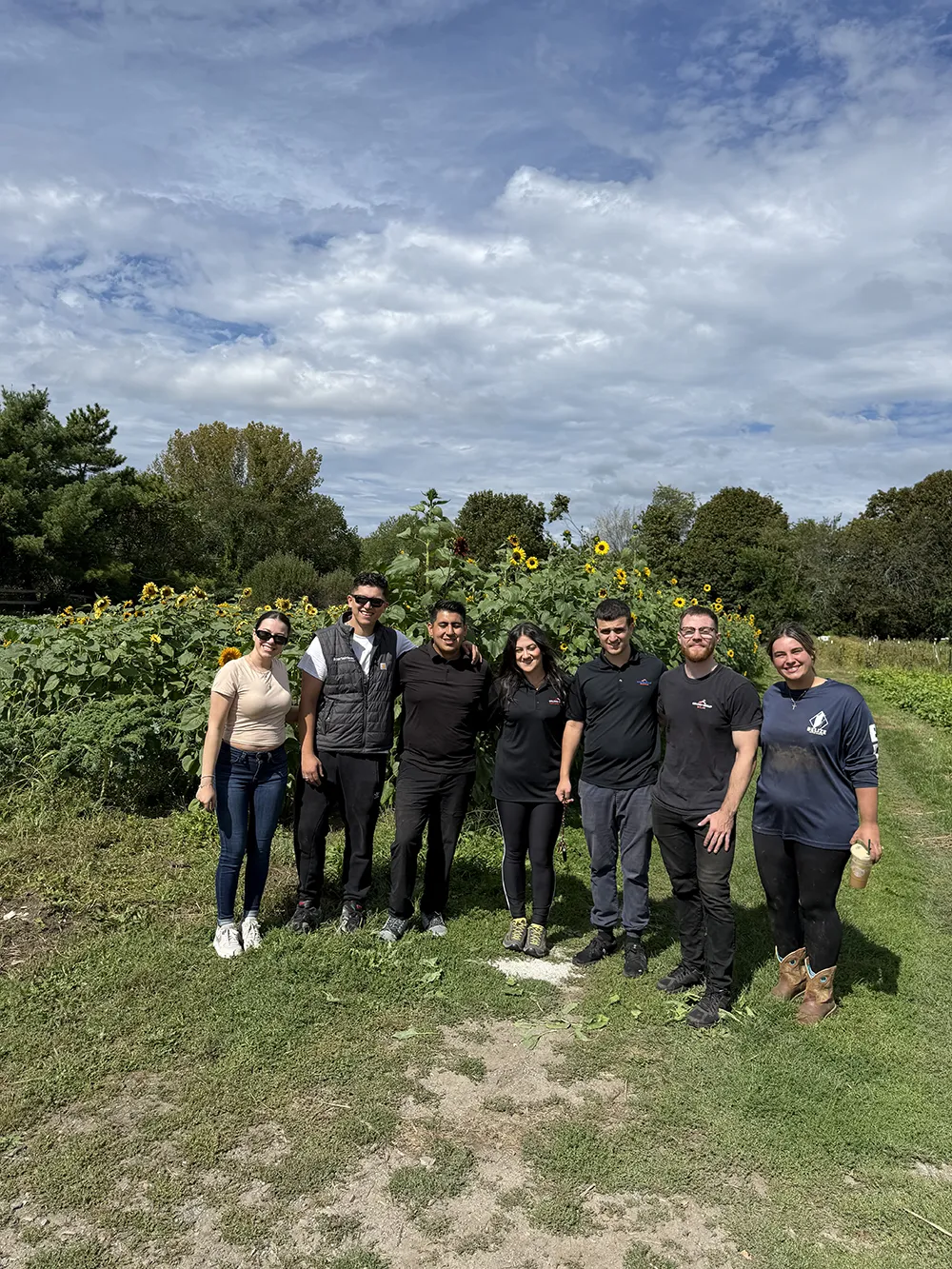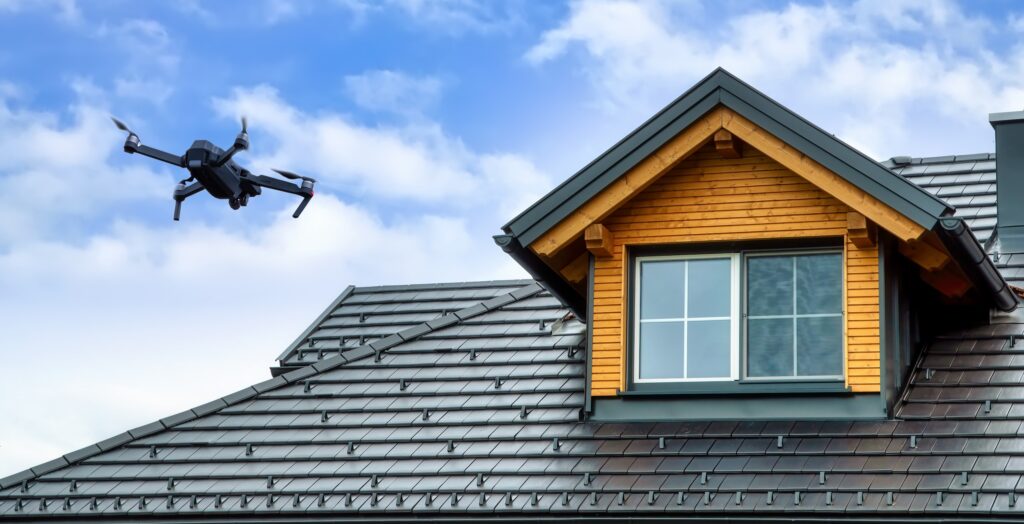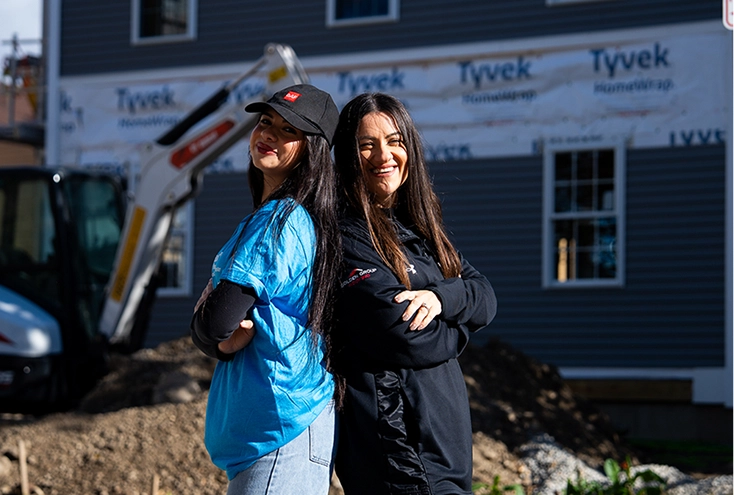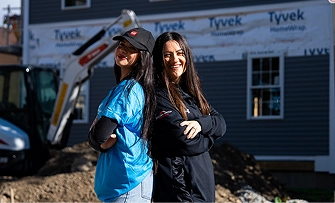Rubber Roofing in Massachusetts
The scoop, and the pros and cons of rubber roofs in the Bay State area
Rubber roofing systems in Massachusetts are cost-effective, durable, and resistant to severe conditions. Are they only for commercial installations? The answer is NO.
Rubber roofing systems, such as EPDM, TPO, or PVC are popular choices for commercial buildings in the Boston and Massachusetts area thanks to their cost-effectiveness, durability, and resistance to severe conditions. Many people ask if rubber roofs are a good choice for residential homes. The answer is YES.
Rubber roofing systems have high-performance benefits for low-slope (flat) roofs, and decks, flat dormers, or flat-topped garages. There are also issues to be aware of when selecting a rubber roof. Read on to learn more.
What is EPDM rubber roofing
EPDM roofing is the only roofing material that EPDM roofing systems fully qualifies as rubber that is used to construct entire roof membranes. EPDM is an acronym for ethlylene propolene diene monomer, the full chemical name of EPDM rubber. It is a durable, waterproof, elastomeric, and highly flexible synthetic rubber which is well suited for use as a single-ply roofing material for several reasons. In its installation, sheets of EPDM rubber are joined together to make a waterproof roof membrane.
Below is a list of benefits and downsides to rubber roofs in New England.
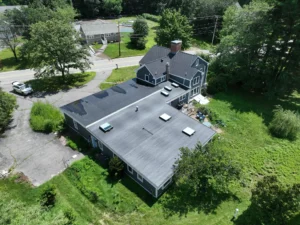
What are the benefits of rubber roofing for your home?
1. They provide durability and longevity.
There are many reasons why a rubber roof may be right for your Boston-area home, but there are some drawbacks to consider. Your roof is a significant investment, and knowing the pros and cons will help you make an informed decision.
2. A rubber roof is weather-resistant.
Rubber roof membranes are specifically engineered to hold up against all types of weather conditions, such as those we experience in Boston, including hail storms, high winds, lightning strikes, torrential downpours, and even falling tree limbs.
3. It’s a quick installation for rubber membranes.
A rubber roof can be installed more quickly than many other roofing systems, such as asphalt shingle roofs. That said, installation will take a bit longer or cost more if there are areas where the roof buts up against vertical structures—such as railings or skylights—that require flashing to prevent leaks.
4. Rubber membranes for your roof are fire-retardant.
Fire hazard is a major risk factor when choosing roofing materials. Rubber roofing is highly flame-retardant, helping to delay the spread of flames during a structural fire and resist catching fire from a nearby structure.
5. There’s no moss and algae growth with rubber roofs.
The materials used in rubber roofing prevent the growth of moss and algae, which can retain moisture, rot wood, lift shingles, or cause leaks over time. This is a common problem in asphalt shingles, often requiring professional cleaning and removal, adding to maintenance costs.
6. They provide fairly easy maintenance.
Rolling long strips of rubber material across the roof decking produces many fewer leak points than attaching individual shingles. Using wider rolls can further reduce potential leaking points along the seams. Rubber roofs are vulnerable to punctures but are relatively easy to patch. Together, these factors lower maintenance and repair costs over the roof’s lifespan.
7. They are cost-effective for Massachusetts homeowners.
Rubber roofing may cost significantly more to install than asphalt shingles. At the same time, the reduced maintenance, high longevity, easy installation, and energy efficiency make it an affordable solution for homeowners in the long run.
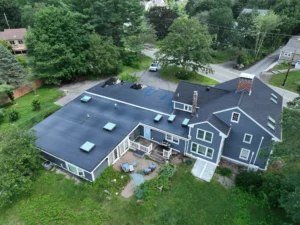
What are the disadvantages of rubber roofing for your Massachusetts home?
1. Black rubber doesn’t have great appearance on your roof
Black across the rooftop looks industrial and not very aesthetically pleasing. Over time, it can appear dirty from long-term accumulation of dirt, dust, and other debris, but regular cleaning can overcome this issue. Some manufacturers produce rubber roofing strips that resemble standard shingles to enhance the look, plus owners can cover the membrane with a wood deck, outdoor carpet, or Astroturf.
2. They can shrink over time.
Shrinkage is one of their most common problems. Ongoing exposure to the elements, foot traffic, and other causes of deterioration can shrink the material. As a result, seams can separate and pull away from parapet walls, penetrations, flashings, and other areas where water can penetrate the decking. Proper design, installation, and maintenance can reduce the shrinkage process.
3. Rubber roofs absorb heat.
The dark color can cause heat pooling, accelerate shrinkage, and drive up cooling costs. Intense daytime heat followed by rapid nighttime cooling also causes the rubber to expand and contract, increasing deterioration and shortening its longevity. Roofers can install lighter, more UV-reflective colors to decrease this shortcoming.
4. They can potentially be punctured if not treated properly over time.
They are relatively vulnerable to punctures caused by sharp items landing on them, such as a nail or high heel shoes. This can also happen if there is bad weather, and weather in the New England area can be quite unpredictable at times.
5. Rubber cannot hold a lot of weight or load on the roof, which is not good in Massachusetts.
A typical rubber roof is not designed to support the weight of continual foot traffic or the construction of other structures–such as a balcony or deck–on top of it. Roofers can take steps to fortify the roof for greater load bearing. If not correctly strengthened, though, high foot traffic, weight, or the continuous pull of gravity can cause seams to pull and open up.
6. Rubber on your roof can have seam issues over time.
While seams on these roofs are quite strong, the bonding adhesive tends to dry out or weaken, possibly causing gaps. They must have regular inspections and servicing to adjust the seams and prevent them from pulling apart.
7. Temperature and proper installation affect roofing construction.
Proper installation requires a temperature of at least 65 degrees. Cooler weather doesn’t allow the adhesive to bind the rubber, leading to lifting and failing. Another option for homeowners is using a low-slope self-adhering, cap and sheet roofing system like LIBERTY™ SBS Self-Adhering cap sheet or base/ply Sheet.
What are the pros of an EPDM roof?
- Keeps the roof cool. White EPDM roof membranes are available, and they come with a white reflective surface. This results in saving energy and keeping the roof temperature cool. However white EPDM costs more than black EPDM and doesn’t typically last as long. Installation is more costly as well. (If installing a cool roof is a primary concern, check the benefits of a TPO or PVC roof.)
- Black EPDM roof membranes absorb and transmit more heat into the building than any other single-ply roof material. In some locations, that can be a desirable quality, as it may help lower heating costs.
- Longevity. An EPDM roof has a lifespan of 40-plus years. When well-maintained and repaired, EPDM roofs can last over 50 years.
- Lower material and installation cost. EPDM roofing will typically cost less than any other single-ply roof system (TPO can cost a bit less.) Ballasted EPDM is the cheapest commercial low-slop roof system you can install. In colder climate areas, EPDM is extremely popular, and installation costs are quite competitive.
- Lower repair costs. Unlike PVC or TPO, which can only be properly repaired using hot air heat welding tools, EPDM can be repaired using pieces of membrane and inexpensive adhesives.
What are the Cons of an EPDM roof?
- Easily damaged. Unreinforced EPDM is susceptible to puncture damage from careless foot traffic and dropped tools. EPDM is also easily damaged by petroleum products and kitchen grease from restaurant kitchen exhaust and leaking or spilled HVAC lubricants.
- Needs frequent inspections. EPDM roofs should be inspected for puncture damage after any storm where wind-blow debris is present.
- Vulnerable to standing water. EPDM roofing depends on adhesives to hold everything together and these adhesives will deteriorate over time when subjected to long-standing water. This poor drainage will cause premature seam failure, taking years off the life of the roof.
- Slippery when wet. EPDM membranes are extremely after it rains. Anyone who needs to access the roof must be very careful and should wait until the roof is completely
- Appearance. EPDM roofs are not attractive, although flat roofs usually cannot be viewed from the ground.
Ballasted EPDM Rubber Roofing Systems
Ballasted EPDM uses the weight of river-washed stones without sharp edges or concrete pavers to hold the roofing membrane in place. The insulation and the roof membrane are loose-laid over the roof deck and the ballast is installed on top. Ballast sone and concrete pavers can be used only at the corners of the roof to hold the membrane in place where increased wind uplift can cause the membrane to come loose. Ballasted systems do not use fasteners or adhesives to attach the roof system to the roof deck. In addition, ballasted systems do not normally include the hard insulation over board that is used to provide impact resistance. The ballast itself performs this function.
Ballasted EPDM roofing is far more susceptible to punctures due to foot traffic than the other systems, as the ballast stone deteriorates over time and develops sharp edges, which careless footsteps can push down into the soft insulation under the membrane.
What other types of rubber roofing material are there?
TPO roofing
TPO roofing is a type of single-ply roofing in which sheets of TPO membrane are used as the primary waterproofing material. TPO, which stands for “thermoplastic polyolefin”, is heat-weldable (thermoplastic) and extremely UV-resistant. TPO is more resistant to standing water on the roof than most other types of modern roofing.
The heat-welded seams in the TPO roof system are exceptionally strong. They are actually stronger than the rest of the TPO sheet. Having heat-welded seams means that adhesives are not used to join the roof membrane sheets together, so adhesive failure and seam delamination are not problems for TPO roofs.
Mechanically fastened 45-mil TPO is the cheapest reflective white commercial roof system there is. Some manufacturers of TPO offer the product in a variety of colors.
When compared to EPDM and PVC, TPO falls in the middle when comparing puncture resistance. It is tougher than EPDM, but not as durable as PVC. TPO has a shorter track record than other roof systems and best practices are still being developed. TPO has a shorter lifespan than other single-ply roofing systems. TPO roof material is white and as such, will need to be cleaned every two to three years. When dirty, the white membrane loses its ability to reflect heat.
In addition, TPO is a stiff membrane and doesn’t always conform to the angles on the roof. This makes installation harder and can result in installation errors even when installed by trained roofers.
PVC Polyvinyl Chloride) Rubber Roofing Systems
In use since the late 1960s, PVC is the third of the three most used types of single-ply roofing materials. PVC is widely used in commercial installations and is a good choice where chemical resistance and resistance to mechanical damage are critical.
PVC is a thermoplastic material which is installed by joining individual sheets together with heat-welded seams. They can be repaired using heat-welded patches for the life of the roof. Because PVC membranes remain weldable even after years of service, they offer an advantage over some other materials that degrade or become more difficult to patch as they age.
Chemical plasticizers are added to the PVC during the manufacturing process to ensure flexibility throughout the life of the roof. These plasticizers prevent the membrane from becoming brittle, especially in cold temperatures, helping to maintain long-term performance.
PVC is highly resistant to UV rays, chemicals, and extreme temperatures. It is particularly resistant to oil, animal fats, and many industrial chemicals, making it a preferred choice for buildings such as restaurants, food processing plants, chemical facilities, and airports. Unlike some other roofing materials, PVC will not significantly deteriorate when exposed to grease, making it ideal for rooftops with kitchen exhaust.
PVC roofing is relatively tough and long-lasting. It can resist foot traffic better than some other roofing systems, making it suitable for roofs with frequent maintenance access or heavy mechanical equipment.
Another advantage of PVC roofing is that it is highly fire-resistant, with inherent flame-retardant properties that help prevent the spread of fire. It is also highly resistant to mold and bacterial growth, which can contribute to long-term durability in humid environments.
White PVC is an excellent choice for energy-efficient roofing applications. It has high reflectivity, which minimizes energy usage by reflecting sunlight and reducing heat absorption. Some manufacturers offer color PVC which provides opportunity for custom aesthetics while maintaining high solar reflectivity,
PVC can last for decades if installed correctly and receives proper maintenance. Many high-quality PVC membranes can exceed 30 years of service life. While PVC is a bit more expensive than TPO, it is easy to install and repair, making it cost-effective. Its durability, chemical resistance, and the ability to long-term weld, provides a lower lifecycle cost.
Overall benefits of rubber roofing for your Massachusetts home
- Durability and longevity.
- Weather resistance (especially in New England and coastal areas), including hail storms, high winds, lightning strikes, torrential rain, and falling tree limbs.
- East and quick installation
- Highly fire-retardant
- Resistant to moss and algae growth
- Easily maintained
- Cost-effective and energy efficient for Massachusetts homeowners
How do you install a rubber roofing systems
The installation process is detailed and requires careful planning. The surface of the roof must be prepped properly. The membrane has to be applied carefully and all seams have to be sealed tightly. Here is an overview of the process:
- Clean and prepare the roof deck.
- Prepare any damaged wood.
- Sweep the roof deck clean
- Lay down the underlayment of roofing felt or a vapor barrier.
- Roll out the rubber membrane over the roof and allow the sheet to relax so any curls or folds are removed
- Mark the seam lines using chalk where overlaps and cuts will .go.
- Test the fit of the membrane around corners and vents.
- Check around chimneys, pipes, or edges.
- Cut out spaces for flashing and trims. This is called dry fitting.
- Starting at one end, the rubber membrane is folded in half to expose the roof deck below.
- The adhesive is applied to the roof deck
- The membrane is re-positioned in place over the roof deck.
- Press the membrane down into the adhesive smoothly and carefully to remove any trapped air bubbles, ensuring a tight, waterproof, and smooth bond.
- The process is repeated with the other sheets of membrane, working carefully to maintain alignment.
- Seal and finish.
- Seam tape is applied to the underlapping sheet.
- Using a seam roller, the bond is secured.
- Lap sealant is applied around the edges of the tape to protect against UV rays and water seeping in.
- Flashing and drip edges are added around vents, pipes, and corners. Metal drip edges are installed around the roof’s perimeter to direct water away from the walls.
- Inspection of completed work, checking for bubbles or gaps. Any loose spots are fixed immediately.
Tips for maintaining your Rubber roof after installation
Maintaining a rubber roof is not complicated. These tips will help extend its life and keep your roof safe.
- Inspect your roof annually.
- Clean your roof twice a year, using a broom or blower to remove leaves and debris. Then wash the surface with mild soap and water.
- Trim overhanging branches that can rub and tear the membrane.
- Check for standing water, especially after a storm.
- Inspect seams and edges, looking for cracks, lifted edges, or bubbles. Apply patch kits or call your roofing professional, if necessary.
- Every five years, ask a rubber roofing professional to conduct a detailed inspection, which may uncover issues you might have missed.
Frequently Asked Questions
Do single-ply rubber roofing materials look attractive?
EPDM is usually black, which isn’t the most aesthetically pleasing. It is available in white, but at a higher price. TPO and PVC are available in white and other colors. White will need more frequent cleaning. Residential customers can cover the rubber roofing material with a wood deck, outdoor carpet, or artificial grass.
How durable are single-ply rubber roofs?
The dark color of rubber roofs can cause heat pooling, which can accelerate shrinkage and increase cooling costs. Intense daytime heat followed by rapid nighttime cooling causes the rubber to expand and contract, increasing deterioration and shortening longevity. Roofers can install lighter, more UV-reflective colors, but this may come at a higher price.
What is roof shrinkage?
Shrinkage is one of the most common problems with rubber roofing. Overtime, exposure to the elements, foot traffic, and other causes can shrink the material. Seams may separate and pull away from parapet walls, flashings, and other areas where water can penetrate the decking. Proper design, installation, and maintenance can reduce the shrinkage process.
Are rubber roofs vulnerable to New England weather?
Rubber can not withstand a lot of weight. A heavy snow load can damage a rubber roof from the load itself or from attempts to clear the roof, which can cause punctures.
What else can cause damage to a rubber roof?
A typical rubber roof is not designed to support the weight of continual foot traffic or the construction of another structure on top – such as a balcony or deck. Roofers will need to take steps to fortify the roof for greater load bearing. If not correctly strengthened, high foot traffic, weight, or the continuous pull of gravity can cause seams to pull apart.
Will seams on single-ply rubber membrane have issues over time?
While the seams on rubber roofs are quite strong, the adhesive tends to dry out or weaken. This has the potential to cause gaps. The roof should be inspected regularly and seams maintained to prevent them from pulling apart.
Will weather conditions affect installation?
Proper installation of rubber roofs requires a temperature of at least 65 degrees F. Cooler weather prevents the adhesive from binding the rubber, leading to lifting of the rubber material.
Can you put rubber roofing over shingles?
No. Shingles will need to be removed prior to installing a rubber roof.
Does a rubber roof cost more than asphalt shingles?
Rubber roofing may cost significantly more to install than asphalt shingles. However, the easy installation, reduced maintenance, longevity, and energy efficiency make it an affordable solution for Massachusetts homeowners.
How do I choose the right membrane material for my roof?
Rubber roofing may be a good choice for you, and you should begin by getting all the information you need to make an informed decision about which type to select. The roofing experts at Golden Group Roofing will discuss the options with you.
Where is Golden Group Roofing located?
Golden Group Roofing has offices in Westborough, Lexington, Hingham, Hudson, Bedford, and Harvard. We serve clients in the Greater Boston area, including Lexington, Hudson, Winchester, Bedford, Lincoln, Wellesley, Newton, Dedham, Needham, Hopkinton, Westborough, Southborough, and Harvard, MA.
Boston area homeowners who have a flat or low-slope roof can certainly consider a rubber roof. In fact, there are many benefits, especially in terms of durability, low maintenance, and long-term affordability. When properly installed and maintained, they can be a great investment in your home.
Questions about the right choice for your roof?
There’s no reason why Boston area homeowners who have a flat or low slope shouldn’t consider a rubber roof. In fact, there are many benefits, especially in terms of durability, low maintenance, and long-term affordability. When properly installed and maintained, they can be a great investment in your home.
If you think a rubber roof may be a good choice, get all the information you need. Call the experts at Golden Group Roofing to discuss your options at 508-873-1884. Our high-quality installation, maintenance, and repair services will ensure you remain warm and dry for decades to come.

